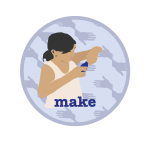Make
Part of these packages: Explore and create
Supported by these technologies: Blogger,
Based on their refined design brief and design ideas, student teams start making. They create their first prototype, and discuss it afterwards. The discussion especially relates to how well the design address the identified design challenges. They then record a reflection and document their activities. Careful guidance through the learning activities and the process of creation is indispensable for students to keep their minds on learning potential curricular requirements. Highlight the reflection after this activity and ensure that everyone focuses on addressing the needs of an audience. To avoid free-riders or unequal workload division, carefully divide tasks and roles within teams. Classroom time: Approximately 2 lesson(s)
1. Prepare / Listen
- Listen carefully to the student comments, and shape the activity according to their needs and interests.
- Expand your competence and expertise by preparing the material, software and technology needed for making.
2. Inspire
- Inspire students to create prototypes that could be used by their audience and that address the identified challenges.
- Team building exercises, such as playing games, solving puzzles or having ice-cream together, can support cooperation and collaboration towards a shared goal.
3. Coach / Question / Support
- Teams develop prototypes. Coach them to address the identified design challenges and to take all collected information into consideration by reminding them of their plans.
- Remind the teams that the activities cumulate towards the creation of an artifact. If you notice teams stalling and debating for too long, step in and support them with hands-on suggestions towards a decision.
- Teams set up their prototypes in the classroom and discuss them with other teams, in particular how and if their prototypes address the identified challenges.
- Teams add the documentation of their design prototype(s) to the blog and describe it, using drawings, videos or digital photographs of their prototypes. Then, they record a reflection. You listen to their reflections and prepare comments for each team.
4. Assess
- Review the work of each team, their reflection recordings and blog entries, to ensure everyone explored and collected examples and/or media files. Then record audiovisual feedback for them. Your feedback might include suggestions and questions.
- Good prototypes illustrate how a design could be used or how it could work. Prototypes can be rough and unfinished, as long as they help in communication. A simple, yet well thought out concept can be as much of a learning experience as a technically intricate execution. Be careful in your assessment of prototypes.
- You could also ask the students to grade their teammates’ contributions, using the student grades to help form your own assessment.
This post is also available in: Spanish Hungarian Turkish











